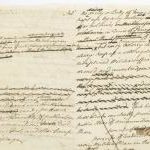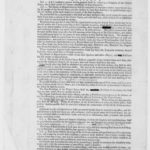While a famous committee of five drafted the Declaration of Independence, a far more unsung committee of thirteen wrote America’s first rulebook. The Articles of Confederation was our first constitution, and it lasted nine years. If you prefer Typee to Moby Dick, Blood Simple to A Serious Man, or Picasso’s Blue Period over Neoclassicism, you just might like the Articles of Confederation.
The fable of its weaknesses, strengths, rise, and downfall are told to us by Danielle Allen, Linda Monk, Joel Collins, and Lindsey Stevens.
This short episode includes a one-page Graphic Organizer for students to take notes on while listening, as well as discussion questions on the back side.
The Constitutional Convention: Lesson 1: The Road to the Constitutional Convention

In February of 1787, Congress authorized a convention, to be held in Philadelphia in May of that year, for the purpose of recommending changes to the Articles of Confederation. In what has come to be known as the Constitutional Convention of 1787, all of the states—with the exception of Rhode Island—sent delegates to debate how to amend the Articles of Confederation in order to alleviate several problems experienced by the United States after the War for Independence.
This lesson focuses on the problems under the Articles of Confederation between 1783 and 1786 leading to the 1787 Convention. Through examination of primary sources, students will see why some prominent American founders, more than others, believed that the United States faced a serious crisis, and that drastic changes, rather than minor amendments, to the Articles were necessary.
Founding Documents: The Constitution Podcast
After just six years under the Articles of Confederation, a committee of anxious delegates agreed to meet in Philadelphia to amend the government. The country was in an economic crisis — citizens couldn’t pay their debts, the government couldn’t really collect taxes, and rebellions were cropping up in states across the nation. The existing government had the potential to drive the country to ruin. So fifty-five men gathered to determine the shape of the new United States.
The document that emerged after that summer of debate was littered with masterful planning, strange ideas and unsavory concessions. The delegates decided they’d be pleased if this new government lasted fifty years. It has been our blueprint for over two centuries now. This is the story of how our Constitution came to be.
This short episode includes a one-page Graphic Organizer for students to take notes on while listening, as well as discussion questions on the back side.
Founding Documents
Discover the documents at the bedrock of our nation’s founding and understand the fundamental ideas from each of the documents, and the major principles of the U.S. Constitution. Primary sources include the Declaration of Independence, Articles of the Confederation, the Constitution and the Bill of Rights, Federalist papers (#51, #70, #78), Brutus #1, and the amazing Letter from the Birmingham City Jail. Check out the National Constitution Center’s learning module for more resources!
The Constitutional Convention
In the summer of 1787, delegates gathered for a convention in Philadelphia, with the goal of revising the Articles of Confederation, the nation’s existing governing document, which wasn’t really working. Instead, they wrote a whole new document, which created a revolutionary form of government: the U.S. Constitution. Read more about the summer of 1787 in the National Constitution Center’s learning module.
The Constitutional Convention of 1787
In this unit, students will examine the roles that key American founders played in creating the Constitution, and the challenges they faced in the process. They will learn why many Americans in the 1780s believed that reforms to the Articles of Confederation were necessary, and the steps taken to authorize the 1787 Convention in Philadelphia. They will become familiar with the main issues that divided delegates at the Convention, particularly the questions of representation in Congress and the office of the presidency. Finally, they will see how a spirit of compromise, in the end, was necessary for the Convention to fulfill its task of improving the American political system.
Article VII: Ratification
After months of debate during the hot Philadelphia summer, on September 17, 1787, the Constitutional Convention finally adjourned and the new Constitution was signed, but it was not the law of the land yet. According to Article VII of the document, nine of 13 states would have to ratify (or approve) the new Constitution before it would officially replace the Articles of Confederation as our governing document.
The Constitutional Convention: Reform or Revolution?
History is the chronicle of choices made by actors/agents/protagonists in specific contexts. This simulation places students at the opening of the Constitutional Convention and asks them to deliberate on the overarching question delegates faced at that moment: Should they propose alterations to the Articles of Confederation, or should they construct an entirely different plan that would supplant the Articles? By engaging with this momentous issue, students will understand the enormity of the “revolution in favor of government” that occurred in 1787.
Drafting the Nation

As the Framers drafted different versions of our founding documents, their ideas of what it meant to be a republic also changed. In this unit, four lessons based on the drafts of the Articles of Confederation, Declaration of Independence, and the Constitution, held at the collection at HSP, allow students to explore the language and ideas behind these pivotal documents
The Constitution: Counter Revolution or National Salvation

It is Fall 1787. The Federal Convention has recently concluded its closed door meetings in Philadelphia and presented the nation with a new model for the government. It is now up to each special state convention to decide whether to replace the Articles of Confederation with this new constitution. The debate is passionate and speaks directly to what the founding fathers had in mind in conceiving this new nation. Does this new government represent salvation or downfall?